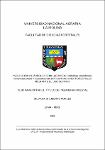Mostrar el registro sencillo del ítem
Selección de árboles semilleros de Cedrelinga cateniformis, Simarouba amara y Guatteria elata en plantaciones forestales, mediante el uso de RPAS
| dc.contributor.advisor | Barrena Arroyo, Víctor Manuel | |
| dc.contributor.author | Di Liberto Porles, Silvana | |
| dc.date.accessioned | 2022-12-16T19:17:12Z | |
| dc.date.available | 2022-12-16T19:17:12Z | |
| dc.date.issued | 2022 | |
| dc.identifier.uri | https://hdl.handle.net/20.500.12996/5551 | |
| dc.description | Universidad Nacional Agraria La Molina. Facultad de Ciencias Forestales. Departamento Académico de Manejo Forestal | es_PE |
| dc.description.abstract | El presente estudio evaluó la factibilidad de seleccionar árboles semilleros utilizando RPAS (Sistema de aeronave pilotada a distancia) en las plantaciones forestales de Cedrelinga cateniformis, Simarouba amara y Guatteria elata del Centro de Investigaciones Jenaro Herrera. Para ello se utilizaron fotografías a color capturadas por un RPA (dron) comercial y se generaron el ortomosaico, modelo digital del terreno y modelo digital de superficie que sirvieron para hallar la posición sociológica, iluminación de copa y forma de la copa de forma visual en el ortomosaico; el diámetro promedio de copa realizando una segmentación de las copas utilizando el ortomosaico y el modelo de alturas, estos datos sirvieron para estimar el dap (diámetro a la altura del pecho) mediante un análisis de regresión lineal; el vigor mediante el NGRDI (Índice de diferencia verde-rojo normalizado); y los valores de altura total se extrajeron del modelo de alturas. Se estableció trabajar con 20 individuos de la plantación C. cateniformis, debido a que no se pudieron ubicar correctamente los individuos georreferenciados de Simarouba amara y Guatteria elata, para realizar la prueba estadística no paramétrica de Wilcoxon y verificar que si existe semejanza estadística entre los datos de campo y RPAS para los parámetros de diámetro promedio de copa y altura total. Finalmente se consideraron todos los parámetros de evaluación excepto la rectitud de fuste y la altura de bifurcación, con una correlación del 50% de los seleccionados en campo en plantaciones forestales donde es posible diferenciar la copa del árbol del suelo, es decir, la vegetación es poco densa. | es_PE |
| dc.description.abstract | The objective of this study was to evaluate the feasibility of selecting seed trees using RPAS (Remotely piloted aircraft system) from forest plantations of Cedrelinga cateniformis, Simarouba amara and Guatteria elata at the Jenaro Herrera Research Station. To do this, color photographs captured by a commercial RPA (drone) were used and the orthomosaic, DTM (Digital terrain model) and DSM (Digital surface model) were generated, which served to find the sociological position, crown lighting and shape of the cup visually in the orthomosaic; the average cup diameter by segmentation of the cups using the orthomosaic and the height model, these data were used to estimate the dap by means of a linear regression analysis; vigor using the NGRDI (Normalized Green-Red Difference Index) using a classification of the generated pixel value; and total height values were extracted from the height model. It was established to work with 20 individuals from the C. cateniformis plantation, because the georeferenced individuals of S. amara and G. elata could not be located correctly, to perform the non-parametric statistical test of Wilcoxon and verify that there is statistical similarity between the field data and RPAS for the parameters of average crown diameter and total height. Finally, all the evaluation parameters were considered except the upright stem and the height of bifurcation, with a correlation of 50% of those selected in field in forest plantations where it is possible to differentiate the crown of the tree from the ground, that is, the vegetation is sparse. | en_US |
| dc.format | application/pdf | en_US |
| dc.language.iso | spa | es_PE |
| dc.publisher | Universidad Nacional Agraria La Molina | es_PE |
| dc.rights | info:eu-repo/semantics/openAccess | en_US |
| dc.rights.uri | https://creativecommons.org/licenses/by-nc-nd/4.0/ | * |
| dc.subject | Cedrelinga cateniformis | es_PE |
| dc.subject | Simarouba amara | es_PE |
| dc.subject | Guatteria elata | es_PE |
| dc.subject | Características agronómicas | es_PE |
| dc.subject | Criterios de selección | es_PE |
| dc.subject | Fitomejoramiento | es_PE |
| dc.subject | Perú | es_PE |
| dc.subject | Producción forestal | es_PE |
| dc.subject | Ramificación | es_PE |
| dc.subject | Semillero | es_PE |
| dc.subject | Drones | es_PE |
| dc.title | Selección de árboles semilleros de Cedrelinga cateniformis, Simarouba amara y Guatteria elata en plantaciones forestales, mediante el uso de RPAS | es_PE |
| dc.type | info:eu-repo/semantics/bachelorThesis | en_US |
| thesis.degree.discipline | Ciencias Forestales | es_PE |
| thesis.degree.grantor | Universidad Nacional Agraria La Molina. Facultad de Ciencias Forestales | es_PE |
| thesis.degree.name | Ingeniero Forestal | es_PE |
| dc.subject.ocde | https://purl.org/pe-repo/ocde/ford#4.01.02 | es_PE |
| renati.author.dni | 76601845 | es_PE |
| dc.publisher.country | PE | es_PE |
| dc.type.version | info:eu-repo/semantics/publishedVersion | en_US |
| renati.advisor.orcid | https://orcid.org/0000-0002-9908-8334 | es_PE |
| renati.advisor.dni | 10375133 | es_PE |
| renati.type | https://purl.org/pe-repo/renati/type#tesis | es_PE |
| renati.level | https://purl.org/pe-repo/renati/level#tituloProfesional | es_PE |
| renati.discipline | 821016 | es_PE |
| renati.juror | Rubín de Celis Llanos, Ethel | |
| renati.juror | Cuellar Bautista, José Eloy | |
| renati.juror | Guillén Quispe, Roxana |
Ficheros en el ítem
Este ítem aparece en la(s) siguiente(s) colección(ones)
-
CFO-MF Tesis [241]





